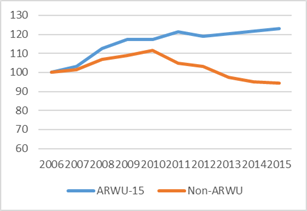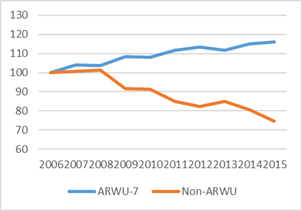One of the knocks against the whole idea of “world-class universities” is that it tends to reinforce institutional privilege; that it’s mostly about big universities with big reputations aiming to expand their financial advantage over everyone else. Without speaking to motive, it is possible to use the financial data I’ve been writing about these last couple of days to examine empirically whether it is true the top dogs are gaining on everyone else or not. And what the data tell us is that in most countries the difference over the past decade is pretty minor.
Let’s start with Canada. Figure 1 shows the difference in real per-student expenditures between the 8 universities that make the ARWU/Shanghai top-200 (i.e. Toronto, UBC, McMaster, McGill, Alberta, Montreal, Calgary and Ottawa) and the rest of the university system. As you can see, the differences are slight.
Figure 1: Real per student Expenditures at Canadian Universities, ARWU-8 vs. rest of sector, 2006=100
This is actually the pattern we see in most countries. In the US, as I showed a few weeks ago the gap between “world-class universities” and the rest has not grown since 2009, either among public or private institutions, though unlike Canada, expenditures at both are increasing substantially (by roughly 15% over ten years). Australia and Japan represent kind of a mid-point between the US and Canada: similar progress from both “world-class” universities and the rest of the sector, but with overall gains in the single-digits.
Figure 2a/2b: Real per student Expenditures at Australian and Japanese Universities, ARWU-unis vs. rest of sector, 2006=100
In Sweden, it’s a similar story, though with larger increases and a rather novel twist. While per-student funding has increased over 20%, total funding has actually only increased 9%. The gap can be explained by declining enrolments, which were due not so much to demographics as a decision by universities that they just didn’t feel like educating quite so many people (more on this back here)
Figure 3: Real per student Expenditures at Swedish Universities, ARWU-5 vs. rest of sector, 2006=100
The only country that had per student increases larger than Sweden was the UK. As with the other countries we’ve seen so far, the changes were more or less the same across “top” universities and the rest of the sector, but the absolute increases are mind-bendingly large.
Figure 4: Real per student Expenditures at UK Universities, ARWU-20 vs. rest of sector, 2006=100
(Go ahead, take a look at that graph, and tell me you are not utterly sandbagged by the idea that UK universities are pleading poor and swear they can’t go two years without a tuition increase).
There are two exceptions to this rule among countries with significant numbers of “world-class universities” where data is available (I’m ignoring China, where data only goes back a couple of years and France where data is simply not made public at all). Germany and Switzerland have seen major increases in funding for top universities while lesser institutions have seen less of a bump. In both cases, the explanation for the gap between world-class universities and the rest lies half in greater investments and half in slower growth in student numbers.
Figure 5a/5b: Real per student Expenditures at German and Swiss Universities, ARWU-unis vs. rest of sector, 2006=100
In short, apart from a couple of examples in central Europe, it is difficult to make the argument that world-class universities are pulling away from the pack, at least in those countries which host the majority of WCUs.








 Tweet this post
Tweet this post

Where is the digaram for the U.S.? Its absence is glaring.
Also, I’d like to see actual numbers, not just rates of change baselined to 2006. Presenting the data thus way looks suspicious.
My bad, there was supposed to be a link in that para to the US data, which I published about a month ago. https://higheredstrategy.com/the-real-competition-is-closer-than-you-think/.
I am really unclear why percentage changes should be considered suspicious.
Excellent articles.